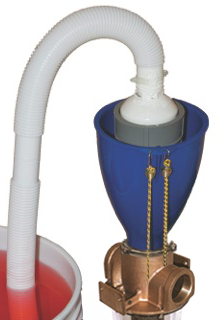mrsrobinson
Well-Known Member
I have winterized many engines, including inboards, but never by myself. I will be winterizing the 3126 CATs by myself this weekend. I am trying to figure out how to do this with me in the engine compartment:
A member here said I could use his SeaFlush. This will make getting antifreeze into the strainers easier, no hoses to disconnect, etc. but with me in the engine compartment pouring antifreeze, how can I see when I have poured enough, and then shut the engines down quickly?
I could place my phone on the dock and video the thru hull. I could then watch the video before disconnecting stuff to make sure a good flow of pink stuff came out. That still leaves shutting down the engine timely though.
My other thought is to disconnect the hose coming out of the strainer, insert a barb fitting, connected to a garden hose, connected to a pump in a 5 gallon bucket full of antifreeze. Similar to the cooper flush I did here, but w/antifreeze and only one hose:
- see the pink stuff come out the thru hull
- shut down the engines quick enough w/out damaging the impellers
A member here said I could use his SeaFlush. This will make getting antifreeze into the strainers easier, no hoses to disconnect, etc. but with me in the engine compartment pouring antifreeze, how can I see when I have poured enough, and then shut the engines down quickly?
I could place my phone on the dock and video the thru hull. I could then watch the video before disconnecting stuff to make sure a good flow of pink stuff came out. That still leaves shutting down the engine timely though.
My other thought is to disconnect the hose coming out of the strainer, insert a barb fitting, connected to a garden hose, connected to a pump in a 5 gallon bucket full of antifreeze. Similar to the cooper flush I did here, but w/antifreeze and only one hose:



